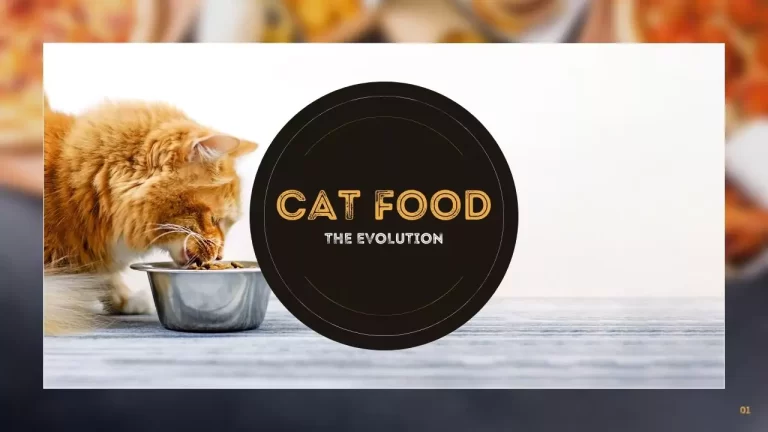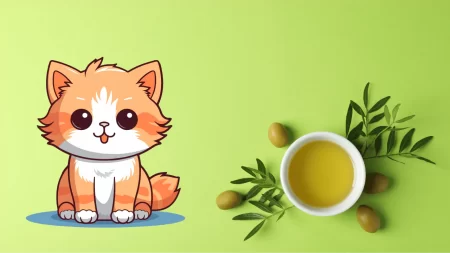Cats are the world’s most popular pets, with 600 million living in families and communities. As cat owners, we want to provide our pets with the greatest diet and care. How did cat food evolve, and what variables shaped it?
This article will discuss the history of cat food and the cat food business, as well as how to choose cat food.
The History of Cat Food
Cats have been tamed since ancient Egypt when they were considered holy. The notion of making cat food was considerably later than for dogs. Cats’ inherent hunting and scavenging abilities led to the assumption that they could survive on their own.
Early Feeding Practices And Domestication Of Cats
When humans farmed their own food and stored grains, cats were valuable to every family. They fed on rats and other pests to protect the food source. Cats sometimes ate human scraps, but their diet was primarily natural.
Some said feeding cats would make them more devoted and excellent hunters, but others said it would spoil and lazily. Some 19th-century authors thought that starving cats would make them weak, diseased, and dangerous.
Rise Of Commercially-Prepared Cat Foods In The 19th Century
People relocated to cities and ceased raising and storing food during the Industrial Revolution. Cats hunted fewer rodents and required more human food. Cat food was still criticized as a luxury for pampered pets.
Following the popularity of dog biscuits created by industrialist James Spratt about 1860, commercial cat food was introduced in the second part of the 19th century. These meat-based cat meals came in little containers or tins. Robinson’s Prepared Cat Food and Liebig’s Extract of Meat for Cats were early cat food companies.
Introduction Of Canned Cat Food In The 1930s
In the 1930s, canned cat food became the next big thing. Canned cat food had more moisture, a longer shelf life, and better taste than dry or semi-moist. Fish, chicken, liver, and cheese might be added to canned cat chow.
In 1931, Illinois-based Chappel Brothers introduced canned cat food with Ken-L Ration. Puss ‘n Boots, Friskies, 9 Lives, and Fancy Feast were early canned cat food brands.
Development Of Dry Cat Foods In The 1950s
Meat shortages and rationing during World War II affected dry cat food creation. Pet owners have to feed their dogs soybeans, grains, and byproducts. Since they didn’t need refrigeration or heating, dry cat feeds were cheaper and more handy than canned ones.
The original dry cat diets were extruded kibbles, created by pushing a combination of ingredients through a die under high pressure and temperature. This produced homogenous kibbles that were easy to package and store. The earliest dry cat food brands were Purina Cat Chow, Whiskas, Meow Mix, and Iams.
Evolution of the Cat Food Industry
As more people understand pet nutrition and care, the cat food market has developed tremendously. Grand View Research estimates the worldwide cat food market was worth USD 31.6 billion in 2019 and would expand 4.4% from 2020 to 2027. Contributing to this increase are:
Growing Awareness And Importance Of Pet Nutrition
As pet owners learn more about their cats’ nutritional requirements, they want higher-quality and more varied cat food. Obesity, diabetes, urinary tract infections, renal illness, and food intolerance are now more known to cat owners. These difficulties have led to specialty cat diets and supplements for weight management, hairball control, dental care, and geriatric care.
Introduction Of Specialized Diets For Different Cat Needs
As indicated above, the cat food business has reacted to the increased need for tailored diets for varied cat requirements by producing a broad selection of products for certain health concerns, life stages, lifestyles, and tastes. Special diets include:
- Prescription diets: Veterinarians prescribe these diets to treat or prevent cat health issues such as urinary tract illness, renal disease, diabetes, and food allergies. Hill’s, Royal Canin, and Purina Pro Plan are prescription diet brands.
- Grain-free diets: No wheat, maize, rice, or barley. Since cats are obligate carnivores, grain-free meals may be better for them. Grain-free diets are not shown to be better for cats, and some studies have connected them to a rare cardiac ailment called dilated cardiomyopathy (DCM). Taste of the Wild, Wellness Core and Blue Buffalo Wilderness are grain-free brands.
- Raw diets: Raw meat, bones, organs, and occasionally fruits and vegetables. Some pet owners think raw meals are better for cats because they mirror their traditional diet and give more nutrients and enzymes than cooked or processed foods. Raw diets may cause bacterial contamination, nutritional imbalance, choking, and preparation and storage issues. Stella & Chewy’s, Primal Pet Foods, and Instinct by Nature’s Variety are raw diet brands.
Advances In Ingredients And Formulation Techniques
Better ingredients and processes have enhanced cat food quality, safety, and performance. Examples are:
- Novel proteins: Rare or exotic animal proteins like venison, rabbit, or kangaroo are less likely to trigger cat allergies.
- Functional ingredients: Cats benefit from probiotics, antioxidants, omega-3 fatty acids, and cranberries.
- Organic ingredients: These are cultivated or farmed without synthetic chemicals or GMOs and are considered healthier than conventional ingredients.
- Human-grade ingredients: These are higher quality and more trustworthy than pet-grade products since they fulfill human food requirements.
Making Informed Choices in Cat Food
With so many cat food choices and promises, it may be challenging for cat owners to pick the finest food. However, several procedures and ideas may help cat owners make educated cat food decisions, such as:
Understanding The Nutritional Needs Of Cats
Cats are obligate carnivores, meaning they get their energy and nutrition from animal protein. Cats need animal-sourced taurine, arginine, arachidonic acid, vitamins A and D, and minerals like calcium and phosphorus. Since they lack enzymes to break down carbs, cats have a limited carbohydrate tolerance.
Therefore, cat owners should choose a meal with at least 30% animal protein, 15% animal fat, and fewer than 10% carbs. Ideally, the protein supply should be single or restricted. The protein and fat sources should be clearly specified. Low-glycemic vegetables and fruits should be the carbohydrate supply.
Reading And Interpreting Cat Food Labels
Cat food labels contain information about ingredients, guaranteed analysis, feeding recommendations, and nutritional value. Cat owners should also be mindful of cat food label restrictions like:
- The ingredients: Pre-processed components are listed in order of weight. This may not represent the quantity or quality of each component after processing. Fresh meat weighs more than dried meat before processing but has less protein. By-products weigh less than entire meats but have more protein after processing. Thus, cat owners should not assess cat food quality or amount by its component list.
- Guaranteed Analysis: A cat food’s certified analysis indicates its minimal and maximum crude protein, fat, fiber, and moisture. This does not indicate the product’s nutritious content or quality. Crude protein may include animal and plant proteins, but cats cannot digest or use all of them. Crude fat may include animal and plant fats, however, not all are good for cats. Thus, cat owners should not use guaranteed analysis to assess a cat food’s nutritional worth or compatibility.
- Feeding instructions: The feeding instructions give the daily cat food quantity depending on weight or age. This is a broad guideline that may not fit all cats. How much a cat eats depends on activity level, metabolism, health, and preference. Thus, cat owners should check their cat’s bodily condition score (BCS), which measures fat and muscle. Cats’ BCS should be 4–5 on a scale of 1–9. To maintain a healthy BCS, cat owners should modify feeding amounts.
- Nutritional sufficiency: The nutritional adequacy statement indicates if a cat food fulfills AAFCO nutritional criteria for particular life stages or objectives. Formulation or feeding experiments may fulfill these guidelines for cat food. AAFCO-formulated cat chow includes the minimum or maximum levels of nutrients for a life stage or function. Feeding trial-approved cat food has been tested on cats and shown to offer appropriate nutrition for a certain life stage or purpose. The feeding experiment is a more dependable and rigorous procedure than formulation for determining cat food standards.
Considering The Quality Of Ingredients
Cat food components impact digestion, palatability, and safety. Cat owners should buy cat food with high-quality, cat-friendly components like:
- Animal proteins: Cats require amino acids, fatty acids, vitamins, and minerals from animal proteins. Cat owners should choose cat food with animal proteins from single or restricted sources, such as chicken, turkey, lamb, beef, salmon, or tuna. Avoid cat food with nonspecific animal proteins including meat, poultry, fish, or animal. Avoid cat food with animal proteins from by-products, meals, rendered fats, or artificial flavors.
- Plant proteins: Cat food does not require plant proteins since they do not supply amino acids, fatty acids, vitamins, or minerals. However, cat food may include plant proteins to improve texture, taste, or color. Plant proteins from natural, organic sources like peas, lentils, carrots, or spinach should be in cat food. Gluten, soy, maize, wheat, and colors should be avoided in cat food.
- Carbohydrates: Cat food does not require carbohydrates since they do not give nutrition. Cat food may include carbs for energy, fiber, or binding. Cat food should include natural, low-glycemic carbs such as sweet potatoes, oats, or barley. Sugar, molasses, and propylene glycol should be avoided in cat food.
- Preservatives: Preservatives reduce deterioration, rancidity, and microbiological development in cat food. Natural or synthetic preservatives affect product shelf life, safety, and taste. Vitamin C, vitamin E, or rosemary extract are good preservatives for cat food. BHA, BHT, ethoxyquin, and sodium nitrite should be avoided in cat food.
Consulting With Veterinarians For Dietary Recommendations
Veterinarian advice on cat food is the last and most crucial stage. Veterinarians provide the greatest expert and tailored recommendations on cat food for each cat’s requirements, tastes, and health. Veterinarians may also assist cat owners track their cat’s weight, body condition score, and health and adapt their feeding schedule. Veterinarians may also recommend special diets or supplements for cats with health issues or allergies and help owners safely transition their cats to new meals.
The Importance of Investing in Quality Cat Food
Quality cat food is one of the greatest ways to keep cats healthy and happy. Quality cat food has several benefits:
- Health benefits: Quality cat food may provide cats with the right nutrition for growth, development, maintenance, and reproduction. Obesity, diabetes, urinary tract infections, renal illness, food intolerance, and more all be prevented or managed with quality cat food.
- Minimizing the risk of health issues and allergies: High-quality components in cat food reduce the likelihood of health disorders and allergies. Quality cat food avoids low-quality or possibly dangerous components that might cause digestive discomfort, allergic responses, or toxicity in cats.
- Long-term cost savings through preventive care: Preventive maintenance with quality cat food saves owners money over time. Quality cat food may decrease veterinarian visits, drugs, treatments, and operations for cats with health issues or allergies. Healthy and happy cats may live longer and better with premium cat food.







